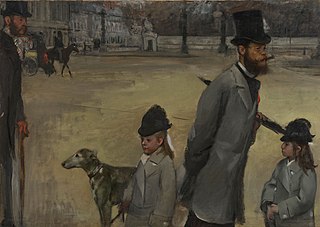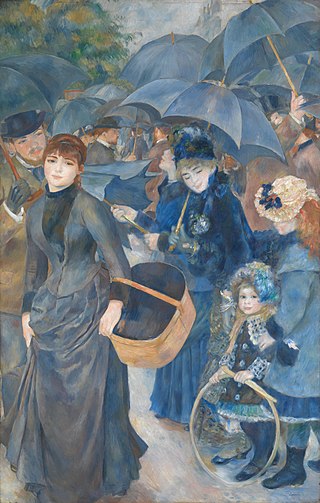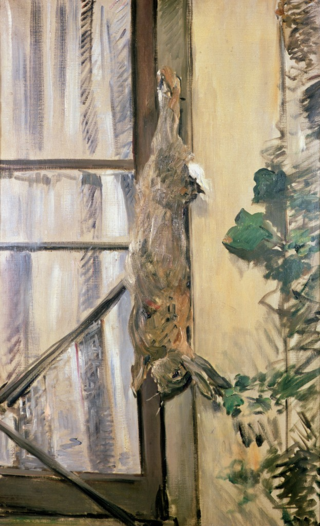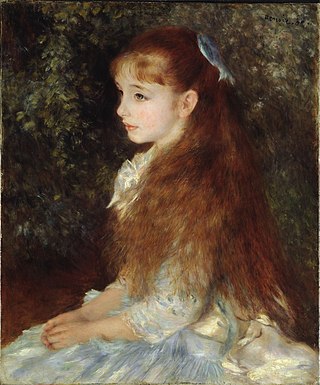
Oscar-Claude Monet was a French painter and founder of impressionist painting who is seen as a key precursor to modernism, especially in his attempts to paint nature as he perceived it. During his long career, he was the most consistent and prolific practitioner of impressionism's philosophy of expressing one's perceptions before nature, especially as applied to plein air (outdoor) landscape painting. The term "Impressionism" is derived from the title of his painting Impression, soleil levant, exhibited in 1874 initiated by Monet and his associates as an alternative to the Salon.

Impressionism was a 19th-century art movement characterized by relatively small, thin, yet visible brush strokes, open composition, emphasis on accurate depiction of light in its changing qualities, ordinary subject matter, unusual visual angles, and inclusion of movement as a crucial element of human perception and experience. Impressionism originated with a group of Paris-based artists whose independent exhibitions brought them to prominence during the 1870s and 1880s.

Pierre-Auguste Renoir was a French artist who was a leading painter in the development of the Impressionist style. As a celebrator of beauty and especially feminine sensuality, it has been said that "Renoir is the final representative of a tradition which runs directly from Rubens to Watteau."

Alfred Sisley was an Impressionist landscape painter who was born and spent most of his life in France, but retained British citizenship. He was the most consistent of the Impressionists in his dedication to painting landscape en plein air. He deviated into figure painting only rarely and, unlike Renoir and Pissarro, he found that Impressionism fulfilled his artistic needs.

National Museum Cardiff is a museum and art gallery in Cardiff, Wales. The museum is part of the wider network of Amgueddfa Cymru – Museum Wales. Entry is kept free by a grant from the Welsh Government.

Luncheon of the Boating Party French: Le Déjeuner des canotiers is an 1881 painting by French impressionist Pierre-Auguste Renoir. Included in the Salon in 1882, it was identified as the best painting in the show by three critics. It was purchased from the artist by the dealer-patron Paul Durand-Ruel and bought in 1923 from his son by industrialist Duncan Phillips, who spent a decade in pursuit of the work. It is now in The Phillips Collection in Washington, D.C. It shows a richness of form, a fluidity of brush stroke, and a flickering light.

Place de la Concorde or Viscount Lepic and his Daughters Crossing the Place de la Concorde is an 1875 oil painting by Edgar Degas. It depicts the cigar-smoking Ludovic-Napoléon Lepic, his daughters Eylau and Jeanine, his dog, and a solitary man on the left at Place de la Concorde in Paris. The man on the left may be the playwright Ludovic Halévy. The Tuileries Gardens can be seen in the background, behind a stone wall.

The Rouen Cathedral series was painted in the 1890s by French impressionist Claude Monet. The paintings in the series each capture the façade of Rouen Cathedral at different times of the day and year and reflect changes in its appearance under different lighting conditions.

The Umbrellas is an oil-on-canvas painting by Pierre-Auguste Renoir, painted in two phases in the 1880s. It is owned by the National Gallery in London as part of the Lane Bequest but is displayed alternately in London and at the Dublin City Gallery The Hugh Lane. From May 2013 to 2019, it returned to Dublin for a six-year period. It is now in the National Gallery London.

The Rabbit is an 1881 oil painting by the French artist Édouard Manet, now displayed at the National Museum Wales in Cardiff, Wales. The work is a still life featuring a hung rabbit or hare which has been placed on a hook outside a closed house window.

Springtime or The Reader is an 1872 painting by the French Impressionist painter Claude Monet. It depicts his first wife, Camille Doncieux, seated reading beneath a canopy of lilacs. The painting is presently held by the Walters Art Museum.

Still Life with Teapot is a still-life oil painting dating between 1902 and 1906, by the French artist Paul Cézanne. The subject of the painting is a table draped loosely with a patterned cloth on which lie fruit, crockery and a knife. The painting was acquired by the National Museum Wales in 1952 and is on display at the National Museum Cardiff.

Dance at Bougival is an 1883 oil-on-canvas painting by the French artist Pierre-Auguste Renoir, currently in the collection of the Museum of Fine Arts in Boston, Massachusetts, USA. Described as "one of the museum's most beloved works", it is one of three in a collection commissioned by Paul Durand-Ruel. It depicts a scene in the French village of Bougival, about 15 km from the center of Paris, a site utilized by many Impressionists besides Renoir including Claude Monet, Alfred Sisley, and Berthe Morisot.
Victor Alfred Paul Vignon was a French Impressionist landscape painter and graphic artist. He was involved with the impressionism movement and its protagonists, as he exhibited at the fifth, sixth, seventh, and eight Paris Impressionist Exhibitions from 1880 to 1886.

Lise with a Parasol is an oil on canvas painting by French artist Pierre-Auguste Renoir, created in 1867 during his early Salon period. The full-length painting depicts model Lise Tréhot posing in a forest. She wears a white muslin dress and holds a black lace parasol to shade her from the sunlight, which filters down through the leaves, contrasting her face in the shadow and her body in the light, highlighting her dress rather than her face. After having several paintings rejected by the Salon, Renoir's Lise with a Parasol was finally accepted and exhibited in May 1868.

Woman with Parakeet is a painting by Pierre-Auguste Renoir created in 1871. It is in the holdings of the Solomon R. Guggenheim Museum in New York as part of the Thannhauser Collection. The painting portrays model Lise Tréhot, who posed for Renoir in over twenty paintings during the years 1866 to 1872.

Portrait of Madame Brunet is an oil painting on canvas by Édouard Manet, begun in 1861 and completed in 1863. Its subject is Caroline de Pène, the wife of the sculptor Eugène Cyrille Brunet. According to Duret she was not beautiful and – although Manet flattered her – she burst into tears when she first saw the painting. It originally depicted the sitter full-length, but by 1867 Manet had cut away the bottom section.

The Portrait of Irène Cahen d’Anvers, or The Little Girl with the Blue Ribbon or Little Irène, is an oil painting by French Impressionist artist Pierre-Auguste Renoir.

Henriette Henriot was an actress and a favourite model of the French artist Renoir from about 1874–1876. She is known for the model in his painting La Parisienne on display at the National Museum, Cardiff.

Madame Georges Charpentier and Her Children is an 1878 oil on canvas painting by Pierre-Auguste Renoir. It depicts Marguerite Charpentier, a French salonist, art collector, and advocate of the Impressionists, and her children Georgette and Paul. The painting is held by the Metropolitan Museum of Art.



















